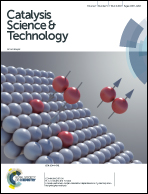A systematic study on mixtures of Pt/zeolite as hydroisomerization catalysts†
Abstract
Mixtures of bifunctional catalysts were studied in the hydroisomerization of n-hexadecane. The study focused on the impact of the properties of individual catalysts on the hybrid catalysts’ performance. On the one hand, a Pt/HUSY catalyst was mixed with a series of Pt/zeolites with different topologies and acidities, all of the catalysts being individually well-balanced. Despite the diversity of Pt/zeolite catalysts in terms of both activity and isomerization selectivity, the performances of the hybrid catalysts corresponded to the average of individual components. Cooperative effects are proposed to be caused by a great difference in the relative activity of the Pt/zeolite catalysts rather than in selectivity. On the other hand, mixtures of large-pore Pt/HUSY and Pt/HBEA catalysts with different Pt loadings were tested. The performance of the resulting hybrid catalysts was observed to be a function of global metal–acid balance. Mixtures of poorly-balanced and well-balanced catalysts can be at the origin of cooperative effects, as demonstrated experimentally by an improved C16 isomer yield. The use of a dual-function kinetic model to simulate the performance of the hybrid catalysts corroborated these interpretations. This comprehensive work is expected to serve as a guideline for uncovering hybrid catalytic systems with industrial applications such as in the hydroisomerization of long chain n-paraffins.

- This article is part of the themed collection: 2017 Catalysis Science & Technology HOT Articles


 Please wait while we load your content...
Please wait while we load your content...